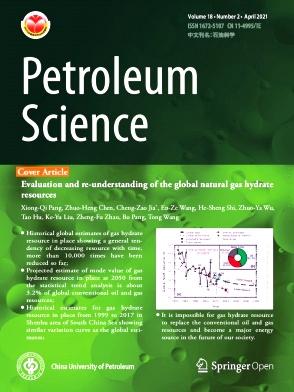四川盆地二叠系白云岩储层生烃和充注史对天然气成因的多学科认识
IF 6
1区 工程技术
Q2 ENERGY & FUELS
引用次数: 0
摘要
由于油气在高温下复杂的热演化和多阶段的成藏过程,了解具有多种潜在烃源岩的深层和超深层储层的天然气成因仍然具有挑战性。利用油气包裹体分析、方解石胶结物U-Pb测年、潜在烃源岩成熟度模拟及附近15号断裂系统复活期约束等方法,研究川东茅口组深部热液白云岩储层天然气成因。结果表明,在246.9 Ma左右发生了一次油充注事件,随后发生了222.4 Ma和175.2 Ma的两次气充注事件。油气充注事件与15号断裂系统活动同步发生,表明15号断裂系统的再激活引起了幕式油气运移。成熟度模拟表明,在充注期,筇竹寺组烃源岩、五峰组—龙马溪组烃源岩和茅口组一段烃源岩分别进入干生气阶段、显著生油阶段和生油阈值阶段。在随后的两期充注期,筇竹寺组和五峰组—龙马溪组分别进入干气和湿气阶段,茅口组一段则进入生油阶段。潜在烃源岩充注时间和成熟度历史表明:1)热液白云岩储层原油主要来源于约246.9 Ma的五峰组—龙马溪组;2)在随后的充注期,五峰组—龙马溪组可能提供湿气,筇竹寺组可能提供干酪根和残余液态烃裂解气;3)热液白云岩储层中所有油均在110 Ma左右发生热裂解成气。研究表明,四川盆地(超)深碳酸盐岩储层气藏具有混合成因,有多种来源的贡献。将油气充注事件的直接测年与油气生成模拟相结合的多学科方法,在识别(超)深层储层天然气成因方面证明了其稳健性和有效性。本文章由计算机程序翻译,如有差异,请以英文原文为准。
Multidisciplinary insights into the origin of natural gas from hydrocarbon generation and charging history of Permian dolomite reservoir in Sichuan Basin
Understanding the origin of natural gas in deep and ultra-deep reservoirs with multiple potential source rocks remains challenging due to the complex thermal evolution of hydrocarbons at high temperatures and multi-stage accumulation processes. This study investigates the origin of natural gas in deep hydrothermal dolomite reservoirs of the Maokou Formation, eastern Sichuan Basin, using hydrocarbon inclusion analysis, radiometric U-Pb dating of calcite cements, maturity modeling of potential source rocks, and constraints on reactivation periods of the nearby No. 15 Fault System. Results indicate an oil charging event at approximately 246.9 Ma, followed by two episodes of gas charging at 222.4 Ma and 175.2 Ma. Furthermore, the oil and gas charging events occurred synchronously with activities of the No. 15 Fault System, suggesting that its reactivation induced episodic hydrocarbon migration. Maturity modeling indicates that during the oil charging period, source rocks in the Qiongzhusi, Wufeng-Longmaxi, and first member of the Maokou formations reached the stages of dry gas generation, significant oil generation, and the threshold of oil generation, respectively. During the subsequent two-episode gas charging periods, the Qiongzhusi and Wufeng-Longmaxi formations progressed to dry and wet gas generation stages, respectively, while the first member of the Maokou Formation attained the oil generation stage. The hydrocarbon charging time and maturity history of potential source rocks indicate that: 1) oil in hydrothermal dolomite reservoirs predominantly originated from the Wufeng-Longmaxi Formation at approximately 246.9 Ma; 2) during the subsequent gas charging episodes, the Wufeng-Longmaxi Formation could contribute wet gas, while the Qiongzhusi Formation likely supplied cracking gas from kerogen and residual liquid hydrocarbon; 3) all oil in the hydrothermal dolomite reservoirs underwent thermal cracking to gas at approximately 110 Ma. This study indicates that gas pools in (ultra-)deep carbonate reservoirs of the Sichuan Basin have mixed genetic origins, with contributions from multiple sources. The multidisciplinary approach, combining direct dating of hydrocarbon charge events and simulation of hydrocarbon generation, proves robust and effective in identifying the origin of natural gas in (ultra-)deep reservoirs.
求助全文
通过发布文献求助,成功后即可免费获取论文全文。
去求助
来源期刊

Petroleum Science
地学-地球化学与地球物理
CiteScore
7.70
自引率
16.10%
发文量
311
审稿时长
63 days
期刊介绍:
Petroleum Science is the only English journal in China on petroleum science and technology that is intended for professionals engaged in petroleum science research and technical applications all over the world, as well as the managerial personnel of oil companies. It covers petroleum geology, petroleum geophysics, petroleum engineering, petrochemistry & chemical engineering, petroleum mechanics, and economic management. It aims to introduce the latest results in oil industry research in China, promote cooperation in petroleum science research between China and the rest of the world, and build a bridge for scientific communication between China and the world.
 求助内容:
求助内容: 应助结果提醒方式:
应助结果提醒方式:


